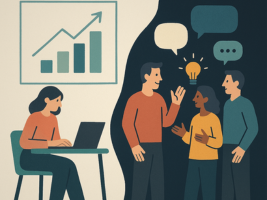Marketing is one of the fields that L&D has always borrowed from, and for good reason. While it has offered us a lot by way of communication and engagement, I’d say that its best contribution to L&D is learner personas.
Personas are a term used very commonly in marketing, and they refer to a fictional characterization of a prospective buyer. Plenty of details are added to make the fictional character feel as real as possible, including their name, where they are from, what they do, their interests, beliefs and challenges, their shopping habits, and so on. The idea is that once you have this persona defined, it becomes easy to have someone close to a real person who is, or might be interested in, checking out your products or services. Based on this understanding, the messaging that is sent out to prospective buyers is adjusted so that they can be persuaded more effectively to come into your store and buy whatever you’re offering.
The premise in L&D is that you create a similar, extensive persona of your learners so that it becomes easier to tweak your messaging to cater to their interests and challenges.
But here’s the thing: There are a couple of fundamental differences between buyer personas (personas used in marketing) and learner personas (those used in L&D).
Difference Between Buyer Personas and Learner Personas #1: Target Group
With buyer personas, you are marketing to the whole wide world, and from within that, you’re picking out your prospective buyers. For instance, let’s say you offer holiday decorations made out of sustainable materials. You have an online store that enables this process, and you offer easy shipping and returns, to make it easier for buyers. In this case, your target group would be all those who celebrate the holiday, maybe within the certain geographical area that you serve. And, your process would be: Find these holiday shoppers and get as many of them as possible to come to your store and purchase your products.
When it comes to learner personas, however, the target group is already defined for you. Let’s say you are creating an organizational induction program. The target in this case would be ALL employees of the organization. You do not have the luxury of saying ‘as many people as possible’.
Even for relatively smaller programs that target fewer employees, such as a program about how to use data to make people decisions for those who work in HR, you want EVERYONE in the HR department to take the program, not just ‘as many as possible’.
Difference Between Buyer Personas and Learner Personas #2: Goal(s)
The other fundamental difference lies in the goal(s) that marketing and L&D are aiming for. Marketing aims to get prospective buyers and convert them into buyers. To be more specific, their aim is to get people to come to the site and then to make the purchase.
L&D’s goals, on the other hand, are two-pronged. Or rather, we are trying to hit two goals instead of one.
One is that we want the learner to come to our course and take it. And the other, perhaps more important goal is that we want them to do whatever it is the course is telling them to do. Straightforward examples for this include:
- For the above example on data utilization, we want the HR team to make use of the available data in their decision making
- And, for a course on risk awareness, we want learners to consider all the risks involved in their projects
Marketing teams do not have to aim for two goals. That would be like saying to a marketer that you have to get a prospect to visit your site and buy your product; in addition, you also have to make sure that they use it!
The Solution?
Now that we’ve established the differences between using personas in marketing and L&D, what can we do about them?
Well, for starters, I would like to break down what a learner persona should contain, for it to be useful.
Marketing folks would normally include things like the buyer’s interests and where they go to shop. Beware of transferring these details into your learner personas, because not only are they not relevant, but they can detract from your goal as well.
Basically, it helps to understand if a characteristic you’re considering impacts their learning or performance. If yes, go ahead and include it, and if not, then drop it. For the example on data awareness that we considered above, here is what one persona might look like.
| # | Category | Details |
| 1 | Name & Designation | Amber Sweeney Executive, HR |
| 2 | Time with the organization | 1.5 years |
| 3 | Goals & objectives | Is ambitious; wants to grow quickly within the organization and start handling a team |
| 4 | Challenges, concerns and pain points | Is extremely time poor; though she’s efficient with her tasks, she barely has time on hand for anything extra |
| 5 | Learning habits | Is a voracious reader, and loves to devour any content that helps her improve at work |
| 6 | Data awareness | Her economics degree gives her a reasonable background in statistics and data awareness; so, when it comes to adopting a more data centric approach than the one that’s currently prevailing, this should help |
| 7 | Interests and favorite pastimes | Loves books and the outdoors; in her free time, you can see her curled up with a book or hiking a trail |
| 8 | Communication channels used | E-mail, slack, the intranet portal, LinkedIn, and a bit of Instagram |
| 9 | Demographics and personal background | Age: 28 Pronouns: She/Her Education: Graduation in economics Personal Information: Single mother to toddler twins – a girl and a boy Other: Identifies as neuro divergent |
In the table above, look at Point #4, “Challenges, concerns and pain points”. This is where you would want to include the challenges that deter learners from:
- Learning, or in other words, taking up the course and going through with it
- Adopting the intended behavior, which in this case, is data-informed decision-making
In our example above, Amber’s challenge is that she’s stretched for time. This will impact her adding learning into her schedule. While this is a challenge that might prevent her from learning, the persona suggests that once she does, she will be willing and able to adopt a more data-informed approach.
There could be (will be) other challenges faced by other learners, both from learning and behavior perspectives. And, these need to be incorporated into the learner personas that you create. For example:
- Noah is not opposed to learning, but is of the opinion that ‘courses’ are useless and boring.
- Trevor strongly believes that HR is a people function, and hence should NOT be using data in their decision-making.
The next point that we need to consider is the number of personas, and what they are based on.
Marketers will tell you that the ideal number is 3-4, and that you can define these personas based on the user’s role, seniority, department, etc. I tend to disagree.
Learner personas should be based on the learner’s challenges, i.e., as we’ve seen above, the thing that prevents them from learning, or adopting the behavior that we’re advocating in the learning program. And, the number should not be limited to just 3 or 4. Basically, you should simply define as many personas as there are challenges. In some cases it could be 3, and in others it could be 5, 8 or even 10.
At this point, think about each and every challenge that your learners might face, for both learning the course, and adopting the desired behavior. Not just challenges, but also the objections they might have. And create a persona around each.
Once you have these personas clearly defined, you can go after and address individual challenges, objections, concerns and pain points, to get learners to take the learning course, as well as to adopt the desired behavior.
Written by Srividya Kumar, Co-Founder @ Learnnovators






